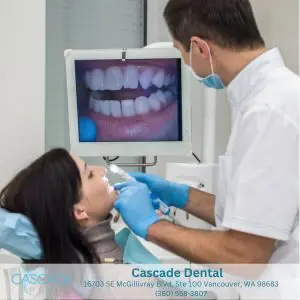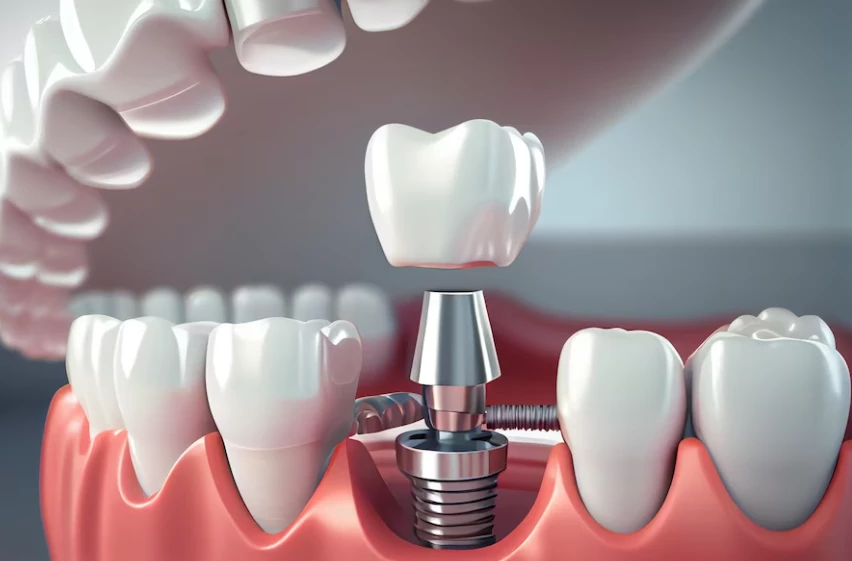Affordable Dental Onlays & Inlays in Vancouver, WA for Natural-Looking Restorations

Transform your smile with high-quality dental onlays and inlays at Cascade Dental in Vancouver, WA. Whether you’re repairing damaged teeth or seeking a more aesthetic restoration, our skilled team offers durable, natural-looking alternatives to traditional fillings and crowns.
What is a Dental Onlay? (Definition, Benefits, and Procedure Explained)
A dental onlay is a custom-made restoration used to treat moderate decay or damage. Unlike dental crowns, which cover the entire tooth, onlays only cover the affected portion, preserving more of your natural tooth structure. Onlays are an ideal solution when the damage isn’t extensive enough to require a crown but needs more than just a filling.
what are the benefits of onlays?
Onlays are porcelain restorations that provide a superior fit and aesthetically pleasing results. Unlike traditional fillings, which cover only the damaged area of the tooth, onlays restore both the cusp and surface of the tooth. This allows them to protect more of your natural tooth structure while providing a longer lasting restoration. The result is an attractive smile makeover with improved overall health benefits as well.
Onlays requires minimal removal of healthy tooth structure and is designed to act as extra support in areas where your teeth need extra reinforcement. They provide superior strength compared to traditional fillings and can last up to twice as long. Additionally, onlays are often more aesthetically pleasing than traditional fillings, due to their color-matching ability and customized fit.
Onlays also provide better protection against tooth decay and wear than other types of restorations. Since they cover more of the tooth structure, they effectively seal out food particles and bacteria that can cause cavities or gum disease. Onlays help reduce sensitivity to hot or cold temperatures by providing an additional layer of insulation for your teeth.
Onlays are a great way to improve the overall health and aesthetic look of your smile in one procedure. With proper care, onlay restorations can last up to 20 years or longer — making them an excellent, long-term investment.
Benefits of Dental Onlays
- Durability: Onlays are strong and can handle daily chewing forces, making them ideal for both front and back teeth.
- Aesthetic Appeal: Crafted from tooth-colored materials like porcelain or composite resin, onlays blend seamlessly with your natural teeth, providing a discreet restoration.
- Conservative Treatment: Onlays require the least amount of tooth structure removal, preserving more of your original tooth compared to crowns.
- Long-Term Solution: Unlike traditional fillings, which may need to be replaced over time, onlays offer a durable solution that lasts for many years.
Dental Onlays vs. Crowns: Which is Right for You?
Both dental onlays and crowns serve to restore damaged teeth, but the main difference is in the extent of coverage:
- Dental Onlays: Cover only the damaged portion of the tooth, leaving more of the natural tooth intact. Ideal for moderate damage, where the tooth’s overall structure is still mostly intact.
- Dental Crowns: Cover the entire tooth, providing additional strength but requiring more of the original tooth to be removed. Crowns are best for extensive decay or damage that can’t be addressed with fillings or onlays.
If you have moderate damage, an onlay is likely the best option, but if your tooth is severely damaged, a crown may be necessary. Dr. Reller at Cascade Dental will guide you in choosing the best treatment based on your specific needs.
Pros and Cons of Dental Onlays
Advantages
- Natural Appearance: Onlays blend naturally with your teeth, making them a great option for those seeking an aesthetic, discreet restoration.
- Long-Lasting: With proper care, onlays can last for many years, making them a cost-effective solution in the long run.
- Less Invasive: Since they preserve more of the natural tooth, onlays require less tooth removal than crowns.
Disadvantages
- Higher Initial Cost: While onlays may cost more upfront than traditional fillings, their durability can save you money over time.
- More Tooth Removal: Onlays still require some removal of the damaged portion of the tooth, which may not be suitable for severely damaged teeth.
What Is a Dental Inlay? (Understanding the Procedure and Benefits)
Dental inlays are similar to onlays but are typically used for smaller cavities that don’t require coverage over the cusps (the pointed parts) of the tooth. Inlays are designed to fit snugly within the cavity, restoring the tooth’s strength and function. They’re custom-made from porcelain, composite resin, or gold, providing a precise, natural-looking fit for your tooth.
Benefits of Dental Inlays
- Precision Fit: Inlays are designed to fit your cavity precisely, restoring both the function and appearance of your tooth.
- Durability: Inlays are durable and can withstand the pressure of chewing, making them a long-lasting solution.
- Aesthetic Appeal: With tooth-colored materials, inlays blend well with your natural teeth, making them an excellent choice for visible teeth.
Types of Dental Inlays: Which Option is Best for You?
There are three main types of inlays, each with its benefits:
- Porcelain Inlays: The most natural-looking option, ideal for visible teeth. Porcelain inlays are highly durable and provide the best aesthetic match for your natural teeth.
- Composite Resin Inlays: These are more affordable and offer a natural appearance, though they may not be as durable as porcelain. Composite resin inlays are also easily shaped to fit the cavity precisely.
- Gold Inlays: Known for their durability, gold inlays are ideal for back teeth that experience significant chewing forces. While gold isn’t as discreet as porcelain or composite, it provides the strongest, longest-lasting solution.
What to Expect After Your Dental Onlay or Inlay Procedure
After your dental onlay or inlay procedure, here’s what you can expect:
- Minimal Discomfort: Any discomfort is usually brief and can be managed with over-the-counter pain relievers. Most patients feel comfortable and return to normal activities quickly.
- Temporary Sensitivity: You might experience some sensitivity to hot or cold, but this should subside as your tooth heals.
- Follow-Up Appointments: We may schedule a follow-up visit to ensure your restoration fits properly and that the healing process is on track.
Cascade Dental will provide you with aftercare instructions to ensure a smooth recovery and optimal long-term results.
Ready to Enhance Your Smile? Schedule a Consultation Today!
If you’re considering dental onlays or inlays to restore your smile, Cascade Dental is here to help. Our team will work with you to determine the best restoration for your needs and ensure a comfortable, efficient procedure.
Contact us today to schedule a consultation and take the first step toward a healthier, more beautiful smile. Call (360) 892-2994 or schedule online for your appointment!

